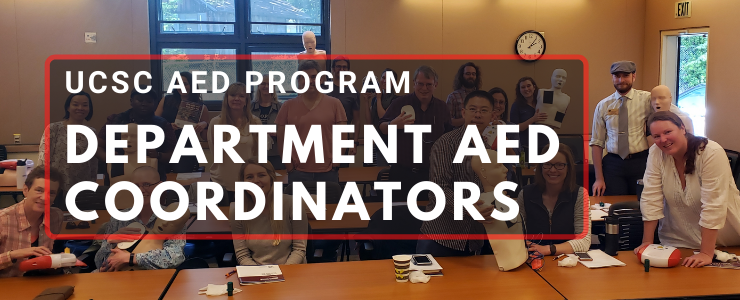The Department AED Coordinators form the backbone of the UC Santa Cruz AED Program. Every department is responsible for the procurement and maintenance of their respective AEDs. To that end, every department appoints at least one Department AED Coordinator to facilitate the maintenance of their AEDs.
A Department AED Coordinator serves as the liaison between Risk and Safety Services and the sponsoring department for all matters relating to the department's AED. As a part of their role, the Department AED Coordinator receives training and support from the Risk and Safety Services to fulfill their responsibilities under the program.
Log Your Monthly AED Inspections
AED Program Document Repository- UCSC AED Program Manual (v2.1 - November 2021)
- Register a New Department AED Coordinator
- Register a New AED
- AED Use Form (English, PDF)
- AED Program Annual Flyer (English, PDF)
- UC Learning Center AED Coordinator Course
New Department AED Coordinators
New Department AED Coordinators have several requirements to fulfill before they can be listed as the department's AED Coordinator. These requirements are listed below as a to-do list.
- Read the UC Santa Cruz AED Program Manual.
- Complete the Department AED Coordinator training on the UC Learning Center.
- Register as the Department AED Coordinator.
Note: The training link should take you directly to the Department AED Coordinator training. If not, search for 'AED' once logged in to the UC Learning Center and select the 'AED Coordinator' ECourse. Please note that the Department AED Coordinator training is not a substitute for AED/CPR Certification.
Procurement of a New AED
Every AED available for public use on campus must be properly registered and maintained in accordance with county guidelines and the California Health and Safety Code. The Program Manual and AED Coordinator Training cover these details that are produced below for your convenience.
- Select an approved AED (RSS recommends the Heartsine 450P or the Zoll AED Plus)
- Select a preferred AED install location.
- Once approval from Risk and Safety Services is given, coordinate the install of the AED.
- Once installed, register the AED for public access.
Maintenance of Department AEDs
The recommended AEDs have component lives of four years. This means that if an AED is not activated during a four-year period, the battery and electrode pads must be replaced. Alternatively, an AED's battery and electrode pads must be replaced after an AED activation or when prompted by the AED itself.
AEDs must be inspected for maintenance at least once every thirty days. Maintenance of AEDs is also covered in the UC Learning Center training. Once a Department AED Coordinator is registered, they will be invited to the LIFELINKcentral AED Management platform, where inspections are regularly logged.
Response Procedures for AED Activation
When an AED is activated, there are several crucial steps that Department AED Coordinators must follow for compliance. These steps include:
- Assist the victim until they are picked up by Emergency Medical Services.
- Have the individuals who used the AED complete an AED Use Form. This form will contain Patient Health Information (PHI) and should not be emailed. Instead, prepare both this filled-out form and the AED itself for pickup from Risk and Safety Services.
- Risk and Safety Services will pick up the form and the AED, extract patient record information, and return the AED to the Department AED Coordinator.
- Procure replacement components for the AED (new batteries, electrode pads).
- Notify Risk and Safety Services that the AED is ready to return to public service.
- Return the AED to public service.


